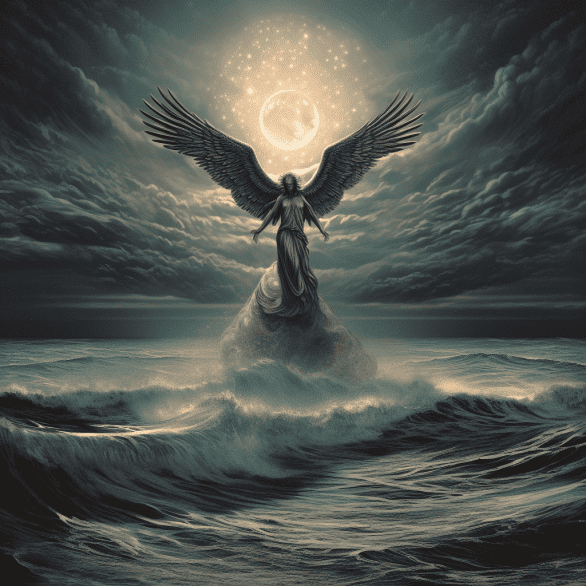The Influence and Significance of Barachiel
The angel Barachiel holds substantial importance within diverse religious texts and belief systems. In certain iterations of Christianity, especially Eastern Orthodoxy and some currents within esoteric Judaism, he is revered for his intercessory function on behalf of humanity. His principal responsibilities encompass overseeing converts’ prayers and presiding over familial harmony.
Furthermore, due to his association with divine blessings and fertility, supplication to him has been prevalent among faithful adherents seeking prosperity or progeny. Therefore, aside from his theological relevance as an archangelic figurehead, Barachiel has also served as a spiritual fulcrum in people’s personal narratives regarding faith and hope.
Art: A Window into Divine Realms
Religious art performs a crucial function by offering visual narratives that elucidate theological concepts or figures otherwise shrouded in mystery. Through various forms—whether they be intricate mosaics adorning Byzantine churches or stained glass windows illuminating Gothic cathedrals—art becomes a medium through which humans can form connections with divine entities.
In this context, artistic depictions significantly contribute to our understanding of angelic beings like Barachiel. Artists have wielded their creative prowess over centuries to portray these celestial beings according to prevailing cultural norms or doctrinal interpretations at given epochs; thus shaping collective perceptions about these divine figures.
Angels in Art: Beyond Abstract Theology
Artistic representations not only humanize celestial figures but also infuse them with definitive attributes that allow for greater accessibility by believers and scholars alike. Angels such as Barachiel are no longer relegated solely within abstract theological discourses but are brought forth into tangibility through art; their visual aesthetic becoming synonymous with their celestial characteristics
Through artistry’s lens—be it painting or sculpture—the viewer apprehends these enigmatic figures like never before; appreciating not only their divine roles but also gaining insights into historical cultures where such artworks were conceived. Consequently, studying angelic depictions presents us with unraveled layers about both the heavenly realm they inhabit alongside earthly societies that endeavored to understand this heavenly realm.
Historical Depictions of Angel Barachiel
A Journey Through Time: Tracing Barachiel in Early Christian and Medieval Art
The historical journey of Angel Barachiel’s portrayal begins in the annals of early Christian art. In the mosaic-studded cathedrals and monasteries of Byzantium, Barachiel often graced frescoes with a serene countenance and an aura of divine authority. The delicate intricacies of these mosaics provide visual narratives that eloquently express the religious devotion and artistic ingenuity of these early craftsmen.
During this period, illuminated manuscripts also held significant sway. Often commissioned by wealthy patrons, they served as an essential medium for disseminating Christian doctrine.
Miniature illustrations within these manuscripts frequently featured angelic figures, including Barachiel. His depictions in these manuscripts reinforced his divine attributes while expressing critical theological concepts through symbolic imagery.
As we traverse further into the Middle Ages, Gothic art heralds elaborately crafted sculptures and awe-inspiring stained-glass windows that featured celestial beings like Barachiel. These mediums brought immense depth to his iconography, enriching it with lifelike expressions that engendered a profound sense of spiritual connection.
In Eastern Orthodox Churches, the evocative power of icons established them as central elements within liturgical practices. Here too, we find depictions of Barachiel characterized by a unique blend of spiritual intensity and aesthetic elegance.
The Renaissance Revelations: A New Vision for Angelic Art
With the advent of Renaissance art, angelic portrayals reached new artistic heights under master painters like Raphael or Michelangelo. These renowned artists infused their works with unparalleled naturalism and emotional depth that cast a fresh light on figures such as Barachiel. Their paintings significantly influenced Western religious art by rendering angels more human-like while retaining their ethereal essence – a paradigm shift that continues to shape ecclesiastical portraiture today.
Symbolism associated with Angel Barachiel
The Language Of Symbols: Unveiling Hidden Meanings Embedded Within}
The exquisite symbolism associated with Angel Barachiel offers profound insights into his character. Often depicted holding roses or surrounded by them, these symbols are not mere embellishments but hold deep significance – roses symbolize blessings from heaven or God’s favor that this angel is believed to distribute among mortals. Another recurring attribute in representations is the staff or scepter – an explicit emblem denoting divine authority entrusted upon him to guide individuals towards grace-filled lives.
Traditional renderings portray him clothed primarily in white symbolizing purity and gold signifying divinity. Such colors imbue his image with transcendental qualities reflecting his heavenly origin & divine functions respectively.
Variations in Depictions Across Different Cultures and Beliefs
A Global Canvas: Diverse Cultural Interpretations Of A Singular Heavenly Figure
Depictions within each religious tradition unveil fascinating nuances about cultural perceptions about this angelic figure! In Eastern Orthodox traditions (e.g., Russian icons), he is typically presented carrying a white cloth covered jar filled with blessings from heaven highlighting their belief system focusing on his role as God’s blessing distributor. Greek Orthodox representations focus more on symbolic aspects portraying him prominently alongside roses reinforcing more abstract theological ideas rather than literal interpretations.
Switching our lens towards Western Christianity uncovers distinct variations as well! Roman Catholic Church’s portrayal often highlights him surrounded by children emphasizing his protective role over families while Protestant artwork tends to present more abstract renditions aligning closely with its less ritualistic approach towards religious practice.
Modern Interpretations Of Angel Barachiel.
Contemporary Expressions : From Religious Art To Pop Culture
Contemporary interpretations exhibit fascinating shifts paralleling broader societal changes reflecting modernist influences over time creating artwork rooted both traditional symbolism & contemporary aesthetics providing viewers innovative perspectives about this archangel! In pop culture too he occasionally pops up showing how enduringly engrained he remains in our collective consciousness transcending strictly religious contexts; appearing even within digital realms such as video games where he sometimes assumes roles quite different from classical depictions!
Conclusion
Our exploration through diverse depictions across various periods firmly establishes how deeply enmeshed this archangel remains within human culture consistently inspiring artistic creativity across generations & geographical boundaries remaining eternally relevant reminding us even today about mysterious yet comforting presence believed guardians guiding us!

